Healing Environment

What Is a Healing Environment?
What exactly contributes to a healing environment? The answer is complex, in part because it can vary based on culture and personal preferences. But current research strongly supports a number of physical and organizational changes that can increase healing in healthcare settings.
 What is healing?
What is healing?
The word healing comes from the Anglo-Saxon word haelen, which means to make whole. One way to look at it is as harmony of mind, body, and spirit.
Healing is not the same as curing (which is more about fixing problems, eradicating disease, and decreasing symptoms). People can be healed even if they are not cured. For example, those with a chronic disease can learn to live in peace with their condition. Conversely, people may be cured but not healed. For example Susan, who had treatment that eliminated her breast cancer, finds herself still grieving and angry at her losses and unable to function.
One common effect of healing is a reduction in stress and anxiety, which in turn positively impacts our bodies in many ways. (For more on this, see What Impact Does the Environment Have on Us?)
What factors create our environment?
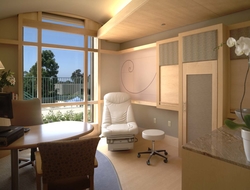 It begins with our interior living spaces and their elements:
It begins with our interior living spaces and their elements:
- Light
- Space
- Color
- Shape
- Texture
- Artwork
Our experience of our living spaces also includes sounds (music), aromas, and sensations (walking on soft carpet or smooth hardwood).
Other Factors
In addition, our experience is also affected by the:
- Larger physical environment: this includes the design of the buildings that surround us in our day-to-day encounters-our homes, the bank, the hospital, and so on and the overall urban design: (if you live in a town or city), which is the layout and elements of streets and neighborhoods.
- Social environment: the people with whom we share the interior space and all the factors associated with them-mood, behavior, and relationship. This also extends out to the various communities of people we belong to.
- Natural environment: the natural surroundings, air, water, earth.
- Interior environment: our memories, as well as our attitudes, beliefs, values, and intentions, which may have the largest impact of all.
How does this apply to healthcare environments?
What factors contribute to a healing environment in healthcare? One answer comes from the Samueli Institute, a non-profit organization dedicated to researching the science of healing. In partnership with experts from around the world, the Samueli Institute developed a model that includes all the factors that surround the patient, family, healthcare practitioner, and community.
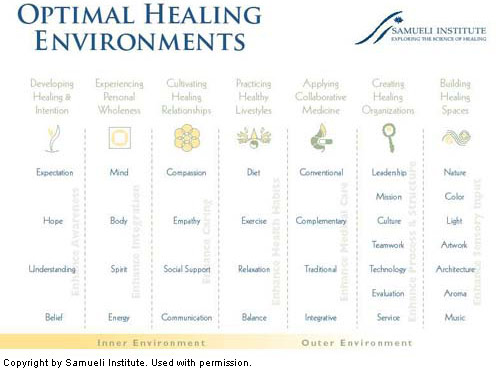
This model includes the places, people, processes, and principles involved in patient care.
As you can see, this model lists factors that impact the inner environment on the left and moves to the right with factors that have a progressively greater impact on the outer environment. Thus healing intention, personal wholeness, and healing relationships are found on the left, healthy lifestyle is in the middle, and collaborative medicine, healing organizations, and healing spaces are on the right.
A holistic perspective is not new
This inclusive view of what is needed to heal is not new. Thousands of years ago, Greek temples were designed to surround patients with nature, music, and art to restore harmony and promote healing.
In the 19th century, Florence Nightingale spoke of the importance of natural light, fresh air, touch, diet, noise control, and spirituality for healing, saying that healthcare providers should "put the patient in the best possible condition so that nature can act and healing occur." Florence also recognized the importance of the internal environment: "To heal, one must be sound in body, mind, and spirit."
Healing spaces in healthcare
Consider, what would you want in a healthcare setting to help with your or a family member's healing? See if any of these environments might help. Are there any that would be less desirable? Why?
What Is Healing About This Hospital?
Which of these healthcare environments appeals to you?
 | 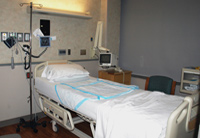 |
| |
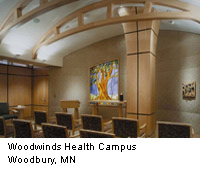 | 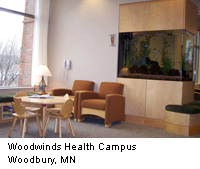 |
| |
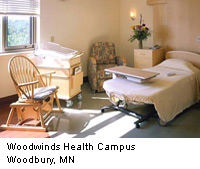 |  |
| |
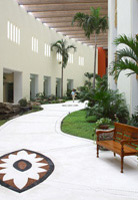 | 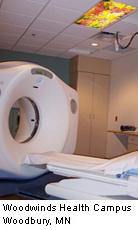 |
What can you do?
What can you do if a family member or close friend is in the hospital, especially for an extended stay? Print out the list of suggestions that you can try.
What does this mean to me as a healthcare consumer?
 A healing healthcare environment can improve the outcome of your hospital or clinic visit-it is as simple as that.
A healing healthcare environment can improve the outcome of your hospital or clinic visit-it is as simple as that.
It can bring comfort and healing to those in other care facilities, such as rehabilitation centers, hospices, assisted living facilities, or long term care facilities. It can also help family and friends cope and increase staff efficiency and morale. So there are strong reasons to seek out such an environment for your healthcare setting.
You can apply what you learn about optimal healing environments to help you choose where to receive care. In the next section, What Impact Does the Environment Have on Us?, we discuss what to look for, according to the latest research.
But what if you are currently limited in your choices? You can still make a significant difference to your own and your family's healing by:
- Making your own temporary changes to hospital or long-term care rooms: for suggestions, see What Can I Do to Create a Healing Environment?
- Considering your inner environment and making desired changes. My Health Planner can help you with this.
- Asking your healthcare facility to incorporate healing environment features.
"The quality of the environment can enhance or retard healing."

